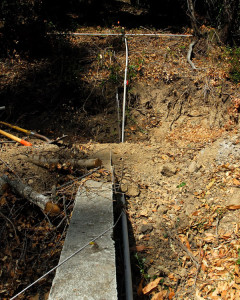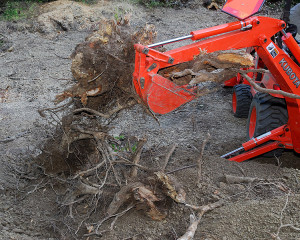Well, this weekend was actually remarkably productive. We finally had some cooler weekend weather, in the low 70s, which made working outside on a sun-exposed hillside much more pleasant.
The first order of business was to start roughing in the main irrigation supply to the orchard and vegetable garden. We’ve spent some time planning the number of watering zones for both areas, and mapping out our irrigation plan. The most important first planting is our cover crop of crimson clover. Weather in fall and early winter along the coast can be quite unpredictable. Although our morning temperature this morning was a brisk 37 degrees, we are well aware that we have the potential for one or more heatwaves before the end of the year. We also expect that rainfall between now and December will be less than regular. As such, we must have the means to supplement rainfall for the clover crop if it is to thrive and help to stabilize our soils on the slope. Thus far we have now installed the main irrigation supply line to the orchard, and the irrigation control valves.
This leaves us with the sprinkler-head installation for the cover crop, and the drip lines for the fruit trees to install. Hopefully one more solid day of work on the hill will see the completion of the irrigation installation in the orchard.
The second battle won this weekend was the removal of a rather large tangle of tenacious tree roots embedded right in the middle of where our shed is to be installed in the vegetable garden. I know, why not move the shed location? We don’t want the shed to cast a shadow across the vegetable gardens of course! The best location for our shed is at the north-east corner of the gardens. Those darn tree roots just had to go.
The tree has been long since dead and cut down, but the stump, in all it’s monsterous glory, was left behind for us to deal with. Earlier this year we improved the road to the vegetable garden area, enabling us to get the tractor out there. Using the back-hoe attachment on the tractor, we began excavating the soil around the stump, and trying to tug the stump loose. This was another of those projects we expected to have done in an hour or so…that in reality consumed the better part of an entire afternoon! At one point it became clear that what initially seemed to be one tree stump, was actually three smaller stumps all knotted together through the root zone. Just as I was thinking that this project might well spill into a second day, one of the smaller of the stumps finally broke free. The remaining clump then seemed more manageable. However, what we hadn’t noticed was the giant 5-6 inch lateral tap root that ran from behind the stump, straight into the toe of the slope behind it. Clearly we needed to sever this monsterous tree root if we had any hope of shaking this stump loose.
As a bonus, the tremendous amount of excavating that was required to remove this stump has actually left us with a perfectly level foundation base for our shed, and that means it’s time to go shed shopping!











